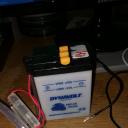Lead Acid Battery Charger Feasibility Question
in Propeller 1
Well I recently purchased a bicycle to get to/from work.
And since the nights are getting darker sooner,
I purchased a dynamo/generator too.
I don't like the way the lights go off when I stop at traffic lights etc...
So I purchased a 6V2Ah lead acid battery.
And a charger, which I hope/think is adequate?
So is it adequate? (please see pic of screen grab)
Mostly the reason for this is that on weekends I usually make a 5 to 6 mile (in each direction ) journey,
And its for that trip back during the late night/early morning time.
And then I thought, what if I could find/make a Propeller powered intelligent charger?
So I've seen a few threads about it on the forums
And just wondered if anyone has done this one already?
And would have any advice for me?
Thank You
And since the nights are getting darker sooner,
I purchased a dynamo/generator too.
I don't like the way the lights go off when I stop at traffic lights etc...
So I purchased a 6V2Ah lead acid battery.
And a charger, which I hope/think is adequate?
So is it adequate? (please see pic of screen grab)
Mostly the reason for this is that on weekends I usually make a 5 to 6 mile (in each direction ) journey,
And its for that trip back during the late night/early morning time.
And then I thought, what if I could find/make a Propeller powered intelligent charger?
So I've seen a few threads about it on the forums
And just wondered if anyone has done this one already?
And would have any advice for me?
Thank You





Comments
There are various algorithms for charging lead acid batteries, but these may not be feasible to accomplish with the variable input of a bicycle dynamo. The CC/CV circuit may be a "good enough" regulator.
If you have specifications for the dynamo output and the power draw for the lights, some reasonable estimates can be made about feasibility. I am assuming that the goal is to have this remain on the bicycle at all times, so let me know if I am way off base.
I was hoping to use the propeller mcu to cotnrol the amount of charge going into the battery to protect it from over charging and to cut off charging when the battery is full.
And at a later stage maybe make more use of the propeller for other use's, after all there would be 7 cores free and a stabilised power supply available.
Thank You for the link, I'm going to view it now
JD
I long ago abandoned dynamos for night riding. I once had to take a rest on what I call a rural 'spaghetti' road that had no shoulder. It was chilly, dark, I was conscious of the cricket noises and I still had a long ride ahead of me.
I use an LED head-light which shines wherever I turn my head.
IMO the lead acid battery is bulky and a dynamo adds drag.
TL431 (or a similar voltage reference) and a comparator accomplishes the voltage threshold task in a much simpler fashion. A dual comparator could then be used to provide both a low-battery warning and a low-battery cut-off (disable). I see this as a simple analog problem that does not necessitate computing power.
Ignoring for the moment whether a dynamo and lead acid are ideal ... they are what are on-hand, so let's take a closer look.
Dynamo - a quick internet search suggests that riding 10mph/16kph will output somewhere in the range of 12VAC and 6W. After adding a rectifier and capacitor, set the trim pots on your charger board to supply something like CV=6.9V and CC=0.5A (top of my head values only, please check against battery manufacturer suggestions).
Lighting - what are the ratings for the lights that you will be using? My first concern is that it seems that the lights are expecting 12VAC from a dynamo and may not perform well with 6VDC input. My second concern is whether the dynamo will have enough capacity to simultaneously power the lights and recharge the battery.
First thing I would consider is switching to led lights. They use a fraction of the power incandescent bulbs do so there would be current left to charge the battery at most speeds. Second thing is to find a buck/boost switching regulator to provide a fixed voltage to the charger and lights.